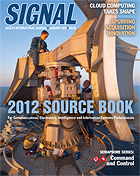
A smartphone that engages in conversations is the next perturbation that will dictate how the U.S. Defense Department needs to revise its information management practices. The effects of this new technology will reverberate from individual communications protocols all the way to data architectures.
Defense Department planners will have to include in their investment programs the availability of tactical consumer radios costing less than $300. The first firm to launch such technology is Apple with its iPhone 4S, which offers intelligent conversational capability. No other consumer computer firm has ever offered that before, but we can be sure that other vendors will follow with similar products.
The iPhone 4S is the first device to offer a reasonable capacity to perform natural language processing using semantic methods. Apple has applied computational linguistics to make possible the conduct of unstructured verbal and text exchanges between computers and humans.
The application that does this is called Siri. For its capacity to talk back, it depends on semantic software that extracts the meaning of words from the Apple cloud. Although Siri still has problems responding to unusual requests, a huge number of programmers currently are enhancing the vocabulary of interactions while Siri keeps “learning” from millions of conversations.
The past 20 years have seen many attempts to endow computers with a conversational capability. These often involved the use of complex and very expensive special-purpose hardware and software. What makes Siri different is its reliance on packaging a combination of conventional as well as innovative features that enable it to engage in simple conversations.
Apple packed into its 4.9-ounce device a number of different wireless communications bandwidths as well as Bluetooth 4.0 wireless. This makes the iPhone a software-defined radio, which covers a spectrum of frequencies. It can be encrypted for security protection.
Defense Department planners can view the iPhone 4S as a harbinger of a revolutionary new approach to how people will interact in the cyber sphere. Other manufacturers will be entering a new technology race. The issue then will be determining which of the many competing public clouds can support their respective devices with a superior capacity to conduct intelligent conversations without delays.
The defense information architecture will need to start adopting systems that support person-centered applications. Though business applications may remain operational in the existing mode for a time, natural language applications should focus on meeting the warfighter’s tactical needs. New systems should be able to offer the capacity to recognize the context of commands; cope with inquiries that ask for summaries of complex data; respond to silent texting without keyboard inputs; recognize diction characteristics of a sender; handle multiple languages for automatic translation of conversations; and connect to diverse applications to obtain instant answers.
They also must address military needs such as allowing for terse communications about missions and objectives; combining GPS, geography and intelligence information; delivering situational awareness to individuals; collecting photo and video intelligence; using facial recognition as a means for biometric identification; tracking all communications and assigning identity to an individual; and dealing with the multiple frequencies that make it a software-defined radio.
Semantic methods depend on an examination of millions of sentences to extract from communications relationships between the syntax of questions and the mostly likely context in which a word or a sentence has appeared before. This requires the use of extremely fast parallel computers that will have to subdivide the task of finding the right answers.
To maintain a 100 percent reliable connection between local cellphone devices and the central repository of semantic intelligence, the Defense Department will have to depend on the availability of a multiplicity of “on the edge” servers. This especially is necessary in the case of deployment of expeditionary forces.
The availability of personal communicators that can hold conversations is a major breakthrough in the evolution of computing. The time has come for Defense Department planners to prepare for it. Intelligent communications will require different data centers and different networks, and work must begin now.
Paul A. Strassmann is the distinguished professor of information sciences at George Mason University. He is the former director of defense information, Office of the Secretary of Defense, and the former chief information officer of Xerox. The views expressed are his own and not necessarily those of SIGNAL Magazine.